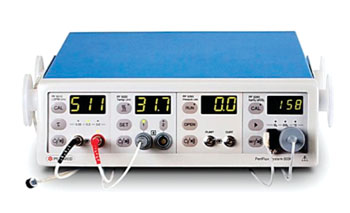Noninvasive Skin Cancer Test Detects Malignant Melanoma
By LabMedica International staff writers
Posted on 01 Sep 2015
A special technique that uses a laser to detect the subtle differences in blood flow beneath the skin enabled scientists to tell the difference between malignant melanoma and noncancerous moles.Posted on 01 Sep 2015
Skin malignant melanoma is a highly angiogenic cancer, necessitating early diagnosis for positive prognosis; however the current diagnostic standard of biopsy and histological examination inevitably leads to many unnecessary invasive excisions.

Image: The Laser Doppler Perfusion Monitor PeriFlux System (Photo courtesy of Perimed).
Scientists at Lancaster University (Bailrigg, UK) working with their colleagues at Pisa University (Italy), performed a cross-sectional study on 55 patients with atypical moles who agreed to have their skin monitored by a laser Doppler system. A clinically atypical nevus was defined as a skin melanocytic lesion with one or more of the following clinical features: asymmetry, border irregularity, color variability and a diameter greater than six mm. Healthy subjects with a clinically benign nevus and patients affected by non-active psoriasis were also recruited as control subjects. Following blood perfusion monitoring, subjects diagnosed with an atypical nevus underwent excision of the lesion, which was then histologically examined.
Blood perfusion monitoring was carried out in the mornings using a Periflux PF4 single point laser Doppler flowmetry apparatus (LDF), (Perimed; Järfälla, Sweden) equipped with an unheated probe. The laser characteristics were: 780 nm wavelength, 10 Hz–19 kHz bandwidth, 0.1 second time constant, 32 Hz sampling frequency. Probe calibration was performed before each session, using a specialized device. The laser Doppler was used to record the complex interactions taking place in the minute blood vessels beneath their suspicious mole for around 30 minutes. The fluctuations in recorded signals were then analyzed using methods developed by physicists at Lancaster University.
On histological examination, the 54 clinically atypical nevi included in the final data resulted in skin malignant melanoma in 10 cases, benign atypical nevi in 33 cases and benign typical nevi in 11 cases. The skin malignant melanoma (SMM) group showed significantly higher average blood flow values at lesion centers and margins compared to both the histologically atypical and the benign typical nevi. The laser Doppler signal correctly identified 100% of the patients with malignant skin.
Aneta Stefanovska, PhD, a professor and a senior author of the study, said, “We used our knowledge of blood flow dynamics to pick up on markers which were consistently different in the blood vessels supplying malignant moles and those beneath normal skin. Combining the new dynamical biomarkers we created a test which, based on the number of subjects tested to date, has 100% sensitivity and 90.9% specificity, which means that melanoma is identified in all cases where it is present, and ruled out in 90.9% of cases where it is not.” The study was published on August 11, 2015, in Nature Scientific Reports.
Related Links:
Lancaster University
Pisa University
Perimed














